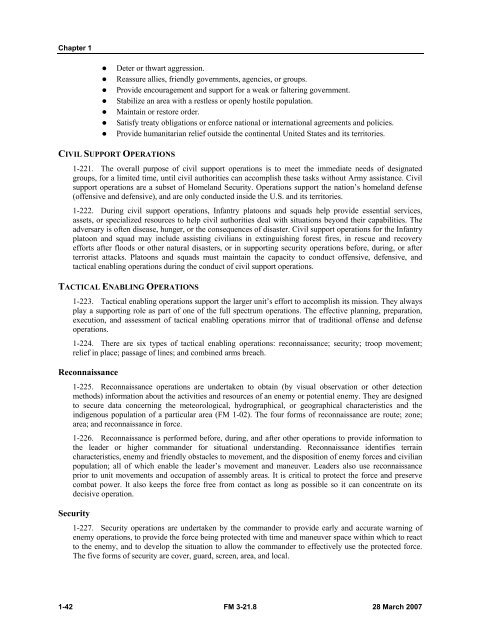Infantry Rifle Platoon and Squad - Sakai
Infantry Rifle Platoon and Squad - Sakai
Infantry Rifle Platoon and Squad - Sakai
You also want an ePaper? Increase the reach of your titles
YUMPU automatically turns print PDFs into web optimized ePapers that Google loves.
Chapter 1<br />
• Deter or thwart aggression.<br />
• Reassure allies, friendly governments, agencies, or groups.<br />
• Provide encouragement <strong>and</strong> support for a weak or faltering government.<br />
• Stabilize an area with a restless or openly hostile population.<br />
• Maintain or restore order.<br />
• Satisfy treaty obligations or enforce national or international agreements <strong>and</strong> policies.<br />
• Provide humanitarian relief outside the continental United States <strong>and</strong> its territories.<br />
CIVIL SUPPORT OPERATIONS<br />
1-221. The overall purpose of civil support operations is to meet the immediate needs of designated<br />
groups, for a limited time, until civil authorities can accomplish these tasks without Army assistance. Civil<br />
support operations are a subset of Homel<strong>and</strong> Security. Operations support the nation’s homel<strong>and</strong> defense<br />
(offensive <strong>and</strong> defensive), <strong>and</strong> are only conducted inside the U.S. <strong>and</strong> its territories.<br />
1-222. During civil support operations, <strong>Infantry</strong> platoons <strong>and</strong> squads help provide essential services,<br />
assets, or specialized resources to help civil authorities deal with situations beyond their capabilities. The<br />
adversary is often disease, hunger, or the consequences of disaster. Civil support operations for the <strong>Infantry</strong><br />
platoon <strong>and</strong> squad may include assisting civilians in extinguishing forest fires, in rescue <strong>and</strong> recovery<br />
efforts after floods or other natural disasters, or in supporting security operations before, during, or after<br />
terrorist attacks. <strong>Platoon</strong>s <strong>and</strong> squads must maintain the capacity to conduct offensive, defensive, <strong>and</strong><br />
tactical enabling operations during the conduct of civil support operations.<br />
TACTICAL ENABLING OPERATIONS<br />
1-223. Tactical enabling operations support the larger unit’s effort to accomplish its mission. They always<br />
play a supporting role as part of one of the full spectrum operations. The effective planning, preparation,<br />
execution, <strong>and</strong> assessment of tactical enabling operations mirror that of traditional offense <strong>and</strong> defense<br />
operations.<br />
1-224. There are six types of tactical enabling operations: reconnaissance; security; troop movement;<br />
relief in place; passage of lines; <strong>and</strong> combined arms breach.<br />
Reconnaissance<br />
1-225. Reconnaissance operations are undertaken to obtain (by visual observation or other detection<br />
methods) information about the activities <strong>and</strong> resources of an enemy or potential enemy. They are designed<br />
to secure data concerning the meteorological, hydrographical, or geographical characteristics <strong>and</strong> the<br />
indigenous population of a particular area (FM 1-02). The four forms of reconnaissance are route; zone;<br />
area; <strong>and</strong> reconnaissance in force.<br />
1-226. Reconnaissance is performed before, during, <strong>and</strong> after other operations to provide information to<br />
the leader or higher comm<strong>and</strong>er for situational underst<strong>and</strong>ing. Reconnaissance identifies terrain<br />
characteristics, enemy <strong>and</strong> friendly obstacles to movement, <strong>and</strong> the disposition of enemy forces <strong>and</strong> civilian<br />
population; all of which enable the leader’s movement <strong>and</strong> maneuver. Leaders also use reconnaissance<br />
prior to unit movements <strong>and</strong> occupation of assembly areas. It is critical to protect the force <strong>and</strong> preserve<br />
combat power. It also keeps the force free from contact as long as possible so it can concentrate on its<br />
decisive operation.<br />
Security<br />
1-227. Security operations are undertaken by the comm<strong>and</strong>er to provide early <strong>and</strong> accurate warning of<br />
enemy operations, to provide the force being protected with time <strong>and</strong> maneuver space within which to react<br />
to the enemy, <strong>and</strong> to develop the situation to allow the comm<strong>and</strong>er to effectively use the protected force.<br />
The five forms of security are cover, guard, screen, area, <strong>and</strong> local.<br />
1-42 FM 3-21.8 28 March 2007

















